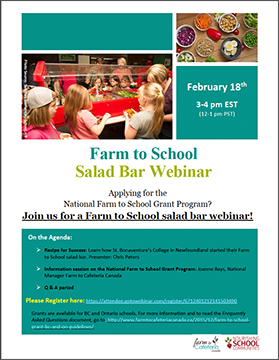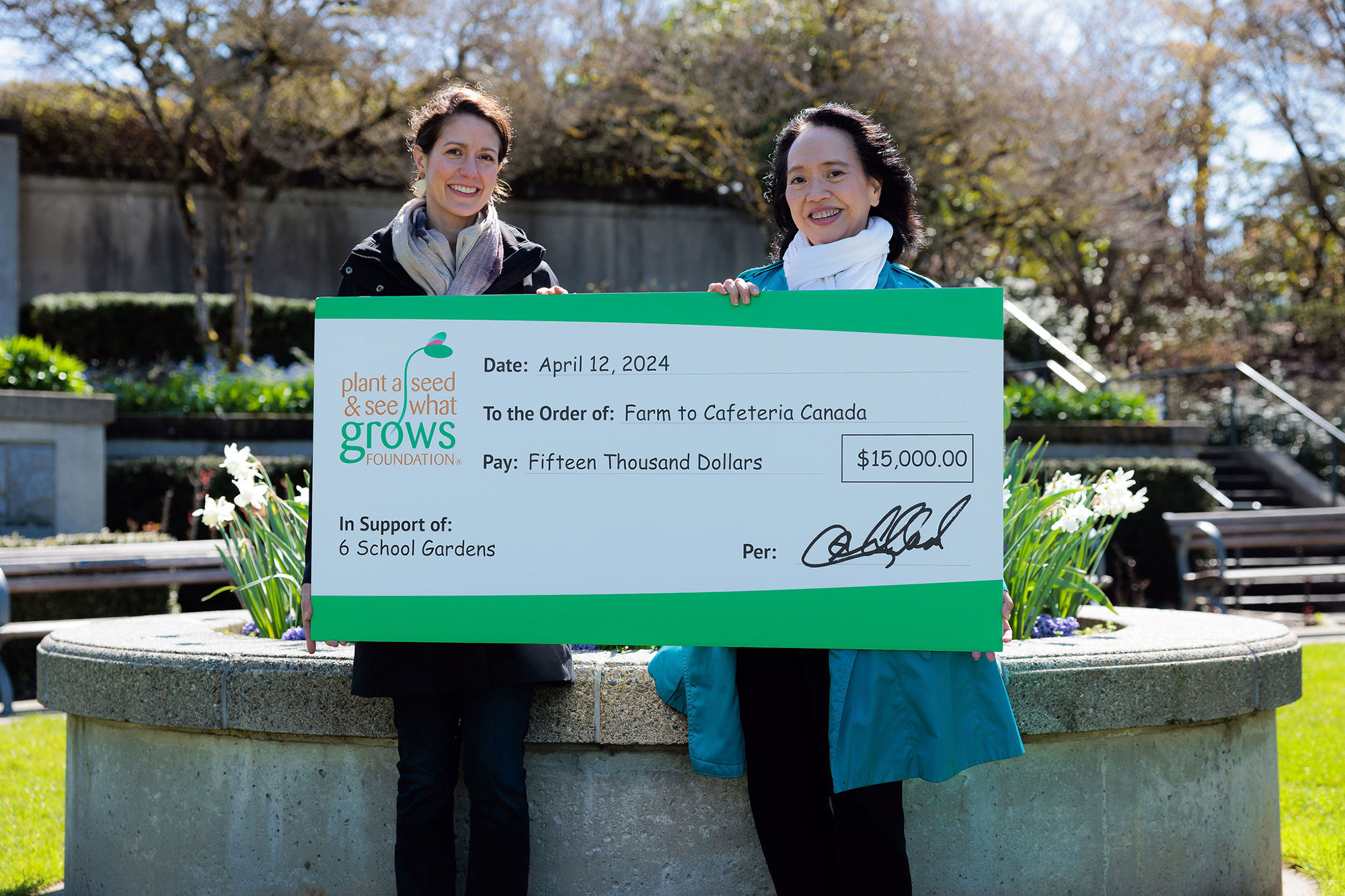Applying for the National Farm to School Grant Program? Watch this Farm to School salad bar webinar!
Webinar Materials:
-
Recipe for Success: Learn how St. Bonaventure’s College in Newfoundland started their Farm to School salad bar
-
Information session on the National Farm to School Grant Program: Joanne Bays, National Manager Farm to Cafeteria Canada
-
Farm to School Grants: Frequently Asked Questions
Farm to School Salad Bar Program Webinar Q&A: Responses from Presenter Chris Peters
How does the local produce get delivered?
A) In our case, the produce is delivered each week by Susan Lester. They have several local restaurants they deliver to and we are just one more stop along the way. Initially, they were not going to charge us as a school for delivery although I think there is a charge within their contract with Chartwell’s.
While Lester’s Farm Market has been very generous to us in terms of donating produce to our program, I would echo Joanne by saying that we are trying to build a network which can be a model for other F2CC programs locally. That is, we want the farmer to be paid fairly for their work and produce. We want to cultivate a relationship of equals. We have been lucky that Lester’s really wants this program to be successful, they want to have their produce in schools, they want kids eating local vegetables from local farms. It’s for this reason that they have been so forthcoming to the school community.
Is the salad bar run by food service staff or volunteers or both?
A) Our salad bar program is wholly run by volunteers. They take the produce delivered by Lester’s and chop, dice, shred it. They transport it to the salad bars. They take temperature readings in the fridge and salad bar as per food health and safety standards in province. They clean the salad bar before and after use.
This has led to a bone of contention because our salad bar is run by volunteers, but all purchases of the salad bar are done through Chartwell’s. Therefore, our salad bar costs $5 but with unlimited servings. I would suggest that you try to be as clear in the initial contract with your school food service provider and farmer as you can be. Specify the work that will be done by the school community (volunteers). Identify a price range that you feel reflects what is consistent and reasonable for everyone. Not that this will be the end price, but at the least there is a dialogue. One of our concerns is we do not know the break down of pricing, profit from Chartwell’s.
Does the garden (school grown) produce end up in the salad bar?
A) At present, it does not. The produce from the St. Bon’s garden is donated to a local food bank attached to the school campus. However, we are working towards integrating school grown produce into our salad bar.
We believe it to be a powerful learning and teaching tool for students to sow seeds, look after them, harvest them and eat them. This places them in a specific locality, better understanding the variables of the growing season and what can grow here.
This is obviously the work the F2CC program does too. We have cultivated a relationship with Lester’s and brought students out to their operations to see how the schools vegetables are grown. The advantage of using the school garden is students need only step outside the classroom and they are immersed in the bio-dynamic world of compost, soil, plants. There’s so many learning and teaching possibilities.
The other bridge we need to cross is figuring out from Chartwell’s end what they might require from a school garden vis-à-vis food safety.
I am curious about the relationship with Chartwell’s. Do they pay the farmer (for their produce)? Is the higher cost of St. Bon’s salad bar to cover Chartwell’s administration?
A) Chartwell’s is our school food service provider. As such, all foods sold through the cafeteria run through them. They have a contract, as per the F2CC program, with Lester’s Farm Market to purchase produce in –season.
So, yes, they do pay Lester’s Farm Market. I’m not sure why the higher cost for the salad bar here as Chartwell’s hasn’t been forthcoming. Their argument has been that the cost of vegetables here in Newfoundland are higher. Which is true. The cost of vegetables in grocery stores in Newfoundland are quite high which reflects the shipping costs. We are at the end of the continental food highway which ships produce from Mexico, California and Arizona to us.
The other side to this is that in buying locally the price is competitive and often lower than grocery store prices. There’s no need to be buying an $8 package of lettuce from California when salad greens thrive in Newfoundland’s wet, cool environment. Carrots, potatoes, turnips, beets- all thrive in Newfoundland’s mineral rich soils and cool growing environment. We do have some trouble with growing peppers and tomatoes and corn- we don’t get that prolonged continental heat. Greenhouses, cold frames and ground cover have all helped local farmers solve some of these environmental realities. But it’s also a teaching moment. Here’s what this place will support. This is what we can’t grow.
This is a long-winded way of saying that I don’t know exactly why we pay a higher price for our salad produce. It is a bone of contention. However, I am confident in our relationship with both Lester’s Farm Market and Chartwell’s and we will continue to have those discussions to make salads affordable but also reflecting the effort the farmer(s) have put into growing the produce. To borrow from Wendell Berry, we cannot have individual health when we are squeezing the farmer to give us produce at lower prices. All we do is deprive her/him of their health, and they in consequence will have to cut corners which will hurt the health of the produce their deliver.





